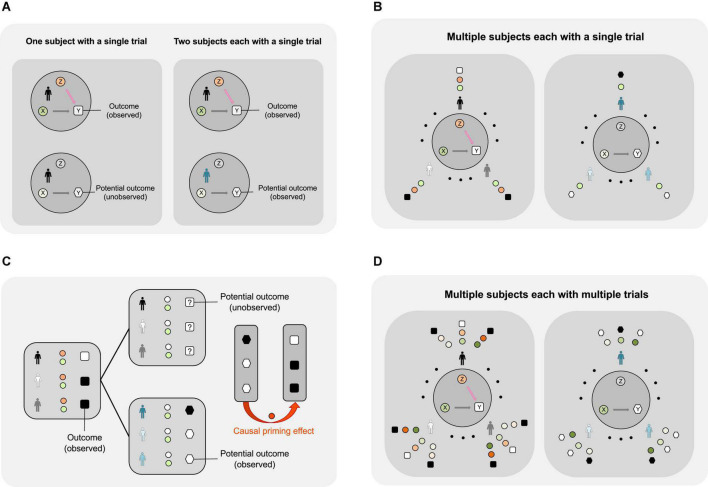FIGURE 2.
Using the potential outcomes framework to study the causal priming effect during a word completion experiment. (A) Identifying the causal priming effect with one trial. Top left: The figure describes a scenario where the subject first conducts a word study (Z = 1) and then aims to identify a target word based on a partial cue (X). The outcome (or Y) is observable. Bottom left: The figure describes a scenario where a subject does not conduct a word study (Z = 0) and aims to identify a target word based on a partial cue (X). If the subject has already participated in a word study, this (potential) outcome (or Y) under no word study is not observable. Top right: The same experiment as in the top left. Bottom right: Since the potential outcome of the subject (indicated by a human icon in black) is not observable, a different subject (indicated by a human icon in blue) is asked to identify the same target word based on the same partial cue (X), without a word study (Z = 0). If the two subjects are similar, then the causal priming effect is estimated by the difference between the outcomes (denoted by a letter Y in a square and a letter Y in a hexagon). (B) To reduce the possibility that a particular word may yield various priming effects on different subjects, multiple individuals are randomized to either conduct a word study (Z = 1) or not (Z = 0). The individuals with grayscale colors receive a word study; the individuals with bright colors do not receive a word study. For the left image, green circles represent various cues, orange circles represent word studies (Z = 1), and black or white squares represent the word study outcomes, where a black square indicates success (Y = 1) and a white square indicates failure (Y = 0). For the right image, green circles represent the cues corresponding to those on the left image, gray circles with the letter Z refer to having not conducted a word study (Z = 0), and black or white hexagons represent the word study outcomes, where a black hexagon indicates success (Y = 1) and a white hexagon indicates failure (Y = 0). (C) Average priming effect of a word study on word identification among multiple subjects using one trial. Left: Half of the subjects are randomized to perform the word identification experiments after a word study (indicated by orange circles). The black and white squares indicate the observed outcomes. Top middle: The potential outcomes of the same subjects (who have participated in a word study) had they not participated in a word study (indicated by blank circles). The squares with question marks indicate that these outcomes are not observable. Bottom middle: The remaining subjects perform the word identification experiments without a word study; the outcomes are observable and are indicated by black and white hexagons for successful and failed cases, respectively. Right: Due to randomization, the difference in the outcomes between the two groups (divided by the sample size) gives an estimate of the average priming effect of the word study on word identification in a sample. (D) The experiment can be further extended to multiple subjects with multiple words.

